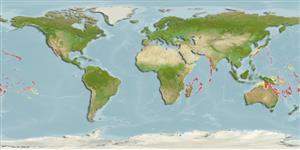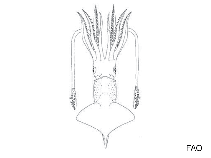Enoploteuthis reticulata Rancurel, 1970
| Native range | All suitable habitat | Point map | Year 2050 |

|
| This map was computer-generated and has not yet been reviewed. |
| Enoploteuthis reticulata AquaMaps Data sources: GBIF OBIS |
Adicionar o seu Fotografias
Imagem do Google | No image available for this species;
drawing shows typical species in Enoploteuthidae.
Imagem do Google | No image available for this species;
drawing shows typical species in Enoploteuthidae.
Classification / Names Common names | Synonyms | CoL | ITIS | WoRMS
Cephalopoda | Oegopsida | Enoploteuthidae
Environment: milieu / climate zone / depth range / distribution range Ecologia
Pelágico(a,os,as); intervalo de profundidade 25 - 215 m (Ref. 100195). Tropical
Distribuição Países | Áreas FAO | Ecossistemas | Ocorrências | Introduções
Indo-Pacific.
Length at first maturity / Tamanho / Peso / Idade
Maturity: Lm ? range ? - ? cm Max length : 13.0 cm ML macho/indeterminado; (Ref. 97142)
Life cycle and mating behavior Maturidade | Reprodução | Desova | Ovos | Fecundidade | Larvas
Members of the class Cephalopoda are gonochoric. Male and female adults usually die shortly after spawning and brooding, respectively. Mating behavior: Males perform various displays to attract potential females for copulation. During copulation, male grasp the female and inserts the hectocotylus into the female's mantle cavity where fertilization usually occurs. Life cycle: Embryos hatch into planktonic stage and live for some time before they grow larger and take up a benthic existence as adults.
Referência principal
Referências | Coordenador | Colaboradores
Bisby, F.A., M.A. Ruggiero, K.L. Wilson, M. Cachuela-Palacio, S.W. Kimani, Y.R. Roskov, A. Soulier-Perkins and J. van Hertum. 2005. (Ref. 19)
Categoria na Lista Vermelha da IUCN (Ref. 130435: Version 2024-1)
Preocupação menor (LC) ; Date assessed: 03 May 2010
Categoria CITES (Ref. 108899)
Not Evaluated
CMS (Ref. 116361)
Not Evaluated
Ameaça para o homem
Utilização humana
| FishSource |
Ferramentas
Mais informação
Trophic Ecology
Itens alimentares
Dieta
Consumo alimentar
Ração
Predadores
Dieta
Consumo alimentar
Ração
Predadores
Ecology
Population dynamics
Crescimento
Idade/Tamanho
Comprimento-peso
Comprimento-comprimento
Frequência de comprimento
Mass conversion
Recrutamento
Abundância
Idade/Tamanho
Comprimento-peso
Comprimento-comprimento
Frequência de comprimento
Mass conversion
Recrutamento
Abundância
Life cycle
Distribution
Human Related
Perfil para aquacultura
Stamps, Coins Misc.
Stamps, Coins Misc.
Outreach
Taxonomy
References
Fontes da internet
BHL | BOLD Systems | CISTI | DiscoverLife | FAO(Publication : search) | Fishipedia | GenBank (genoma, nucleotídeo) | GloBI | Gomexsi | Google Books | Google Scholar | Google | PubMed | Árvore da vida | Wikipedia (ir para, procurar) | Registo zoológico
Estimates based on models
Preferred temperature
(Ref. 115969): 22.7 - 24.9, mean 23.5 (based on 7 cells).



